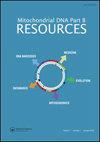Rhabdophis chiwen(有鳞目:颊鳃科)的完整线粒体基因组和系统发育分析。
IF 0.5
4区 生物学
Q4 GENETICS & HEREDITY
Mitochondrial DNA. Part B, Resources
Pub Date : 2024-10-21
eCollection Date: 2024-01-01
DOI:10.1080/23802359.2024.2417975
引用次数: 0
摘要
迄今为止,戚文横纹夜蛾发现于中国四川省,主要以蚯蚓和萤火虫幼虫为食。本研究对戚文鱼的线粒体基因组进行了测序和分析,测序长度为 17,646 bp,包含 37 个基因和两个控制区。系统进化分析表明,螭文属于蛛形纲,与虎纹蛙是姊妹支。这项研究成功地获得了第一份完整的R. chiwen线粒体基因组,为其进化史和保护提供了重要的遗传数据。本文章由计算机程序翻译,如有差异,请以英文原文为准。
The complete mitochondrial genome and phylogenetic analysis for Rhabdophis chiwen (squamata: colubridae).
Rhabdophis chiwen is currently found so far in Sichuan Province, China, where it predominantly feeds on earthworms and firefly larvae. In this study, we sequenced and analyzed the mitochondrial genome of R. chiwen, which measured 17,646 bp in length and encompassed 37 genes along with two control regions. The base composition revealed percentages of 33.20% A, 25.94% T, 13.27% G, and 27.59% C. Phylogenetic analyses indicate that R. chiwen belongs to the family Colubridae and forms a sister branch with R. tigrinus. This study successfully obtained the first complete mitochondrial genome of R. chiwen, offering crucial genetic data for its evolutionary history and conservation.
求助全文
通过发布文献求助,成功后即可免费获取论文全文。
去求助
来源期刊

Mitochondrial DNA. Part B, Resources
Biochemistry, Genetics and Molecular Biology-Molecular Biology
CiteScore
1.30
自引率
20.00%
发文量
670
期刊介绍:
This open access journal publishes high-quality and concise research articles reporting the sequence of full mitochondrial genomes, and short communications focusing on the physical, chemical, and biochemical aspects of mtDNA and proteins involved in mtDNA metabolism and interactions.
 求助内容:
求助内容: 应助结果提醒方式:
应助结果提醒方式:


